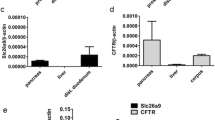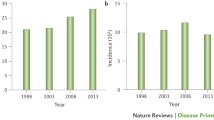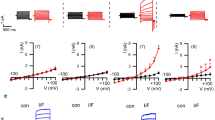Abstract
Recently we have created a mouse model of cystic fibrosis (CF) by insertional gene targeting to exon 10. In common with CF subjects, this model displays a low incidence of meconium ileus. This contrasts strikingly with the very high level of fatal intestinal obstruction in the three other CF mouse models so far described. We investigate here the molecular basis of this difference in phenotype. We show that the partial duplication consequent upon insertional gene targeting allows exon skipping and aberrant splicing to produce normal Cftr mRNA, but at levels greatly reduced compared with wild-type mice. Furthermore, instead of the predicted mutant Cftr transcript, a novel mRNA is produced that utilizes cryptic splice sites in the disrupting plasmid sequence. However, we have previously shown that these mice display the ion transport defect characteristic of CF, and mutant animals can be distinguished from their normal littermates on this basis. Consistent with this, residual CFTR function has recently been observed for several “mild” mutations in CF individuals who display pancreatic sufficiency but still develop lung disease. We conclude that (i) residual wild-type mRNA in the exon 10 insertional mutant mouse ameliorates the severity of the intestinal phenotype observed in the absolute “null” CF mice, (ii) the presence of low-level residual wild-type Cftr mRNA does not correct the CF ion transport defect, and (iii) the long-term survival of this insertional mutant mouse provides the opportunity to address the factors important in development of lung disease.
Similar content being viewed by others
References
Alton, E.W.F.W., Middleton, P.G., Caplen, N.J., Smith, S.N., Steel, D.M., Munkonge, F.M., Jeffrey, P.K., Geddes, D.M., Hart, S.L., Williamson, R., Fasold, K.I., Miller, A.D., Dickinson, P., Stevenson, B.J., McLachlan, G., Dorin, J.R., Porteous, D.J. (1993). Non-invasive liposome-mediated gene delivery can correct the ion transport defect in cystic fibrosis mutant mice. Nature Genet. 5, 135–142.
Boat, T., Welsh, M.J., Beaudet, A. (1989). Cystic fibrosis. In The Metabolic Basis of Inherited Disease C. Scriver, A. Beaudet, W. Sly, W. Valle, eds. (New York: McGraw-Hill), pp 2649–2680.
Boyd, A.C. (1993). Turbo cloning: a fast, efficient method for cloning PCR products and other blunt-ended DNA fragements into plasmids. Nucleic Acids Res. 21, 817–821.
Capecchi, M. (1989). The new mouse genetics—altering the genome by gene targeting. Trends Genet. 5, 70–76.
Colledge, W.H., Ratcliff, R., Foster, D., Williamson, R., Evans, M.J. (1992). Cystic fibrosis mouse with intestinal obstruction. Lancet 340, 680.
Chu, C-S., Trapnell, B., Murtagh, J., Moss, J., Dalemans, W., Jallat, S., Mercenier, A., Pavirani, A., Lecocq, J-P., Cutting, G., Guggino, W., Crystal, R. (1991). Variable deletion of exon 9 coding sequences in cystic fibrosis transmembrane conductance regulator gene mRNA transcripts in normal bronchial epithelium. EMBO J. 10, 1355–1363.
Clarke, L.L., Grubb, B.R., Gabriel, S.E., Smithies, O., Koller, B.H., Boucher, R.C. (1992). Defective epithelial chloride transport in a genetargeted mouse model of cystic fibrosis. Science 257, 1125–1128.
Cystic Fibrosis Genotype-Phenotype Consortium (1993) Correlation between genotype and phenotype in patients with cystic fibrosis. N. Engl. J. Med. 329, 1308–1313.
Daar, I., Maquat, L. (1988). Premature translation termination mediates triose phosphate isomerase mRNA degradation. Mol. Cell Biol. 8, 802–813.
Delaney, S., Rich, D., Thomson, S., Hargrave, M., Lovelock, P., Welsh, M.J., Wainwright, B.J. (1993). Cystic fibrosis transmembrane conductance regulator splice variants are not conserved and fail to produce chloride channels. Nature Genet. 4, 426–431.
Dorin, J.R., Dickinson, P., Alton, E.W.F.W., Smith, S.N., Geddes, D.M., Stevenson, B.J., Kimber, W.L., Fleming, S., Clarke, A.R., Hooper, M.L., Anderson, L., Beddington, R.S.P., Porteous, D.J. (1992). Cystic fibrosis in the mouse by targeted insertional mutagenesis. Nature 359, 211–215.
Hamosh, A., Trapnell, B.C., Zeitlin, P.L., Montrose-Rafizadeh, L., Rosenstein, B.J., Crystal, R., Cutting, G. (1991). Severe deficiency of cystic fibrosis transmembrane conductance regulator mRNA carrying nonsense mutations R553X and W1316X in respiratory epithelial cells of patients with cystic fibrosis. J. Clin. Invest. 88, 1880–1885.
Jackson, I.J. (1991). A reappraisal of non-consensus mRNA splice sites. Nucleic Acids Res. 19, 3795–3798.
Lim, S.-K., Sigmund, C.D., Gross, K.W., Maquat, L.E. (1992). Nonsense codons in human β-globin mRNA result in the production of mRNA degradation products. Mol. Cell. Biol. 12, 1149–1161.
McIntosh, I., Hamosh, A. Dietz, H.C. (1993). Nonsense mutations and diminished mRNA levels. Nature Genet. 4, 219.
Mearns, M. (1992) Cystic fibrosis: the first 50 years. A review of the clinical problems and their management. In Cystic Fibrosis: Current Topics, vol 1. J.A. Dodge, D.J.H. Brock, J.H. Widdicombe, eds. (Chichester: J. Wiley & Sons)s, pp 000–000.
Moens, C.B., Auerbach, A.B., Conlan, R.A., Joyner, A.L., Rossant, J. (1992). A targeted mutation reveals a role for N-Myc in branching morphogenesis in the embryonic mouse lung. Genes Dev. 6, 691–704.
O'Neal, W.K., Hasty, P., McCray, P.B., Casey, B., Rivera-Perez, J., Welsh, M.J., Beaudet, A., Bradley, A. (1993). A severe phenotype in mice with a duplication of exon 3 in the cystic fibrosis locus. Hum. Mol. Genet. 2, 1561–1569.
Ratcliff, R., Evans, M.J., Cuthbert, A.W., MacVinish, L.J., Foster, D., Anderson, J.R., and Colledge, W.H. (1993). Production of a severe cystic fibrosis mutation in mice by gene targeting. Nature Genet. 4, 35–41.
Riordan, J.R., Rommens, J.M., Kerem, B.-S., Alon, N., Rozmahel, R., Grzelczak, Z., Zielenski, J., Lok, S., Plavsic, N., Chou, J.-L., Drumm, M.L., Ianuzzi, M.C., Collins, F.S., Tsui, L.-E. (1989). Identification of the cystic fibrosis gene: cloning and characterization of complimentary DNA. Science 245, 1006–1073.
Robberson, B., Cote, G., Berget, S. (1990). Exon definition may facilitate splice site selection in RNAs with multiple exons. Mol. Cell. Biol. 10, 84–94.
Sheppard, D.N., Rich, D.P., Ostedgaard, L.S., Gregory, R.J., Smith, A.E., Welsh, M.J. (1993). Mutations in CFTR associated with mild-disease-form CI channels with altered pore properties. Nature 362, 160–164.
Smith, S.N., Alton, E.W.F.W., Geddes, D.M. (1992) Ion transport characteristics of the murine trachea and caecum. Clin. Sci. 62, 667–672.
Snouwaert, J.N., Brigman, K.K., Latour, A.M., Malouf, N.N., Boucher, R.C., Smithies, O., Koller, B. (1992). An animal model for cystic fibrosis made by gene targeting. Science 257, 1083–1088.
Tata, F., Stanier, P., Wicking, C., Halford, S., Kruyer, H., Lench, N.J., Scambler, P.J., Hansen, C., Braman, J.C., Williamson, R., Wainwright, B.J. (1991). Cloning the mouse homologue of the human cystic fibrosis transmembrane conductance regulator gene. Genomics 10, 301–307.
Urlaub, B., Mitchell, P.J., Ciudada, C.J., Chasin, L.A. (1989). Nonsense mutations in the dihydrofolate reductase gene affect RNA processing. Mol. Cell. Biol. 9, 2868–2880.
Welsh, M.J. (1990). Abnormal regulation of ion channels in cystic fibrosis epithelia. FASEB J. 4, 2718–2725.
Yamaguchi, M., Hayashi, Y., Hiroshe, F., Matsuoka, S., Moriuchi, T., Shiroishi, T., Moriwaki, K., Matsukage, A. (1991). Molecular cloning and structural analysis of mouse gene and pseudo genes for proliferating cell nuclear antigen. Nucleic Acids Res. 19, 3795–3798.
Yorifuji, T., Lemna, W.K., Ballard, C.F., Rosenbloom, C.L., Rozmahel, R., Plavsic, N., Tsui, L.-C., Beaudet, A.L. (1991). Molecular cloning and sequence analysis of the murine cDNA for the cystic fibrosis transmembrane conductance regulator gene. Genomics 10, 547–550.
Author information
Authors and Affiliations
Rights and permissions
About this article
Cite this article
Dorin, J.R., Stevenson, B.J., Fleming, S. et al. Long-term survival of the exon 10 insertional cystic fibrosis mutant mouse is a consequence of low level residual wild-type Cftr gene expression. Mammalian Genome 5, 465–472 (1994). https://doi.org/10.1007/BF00369314
Received:
Accepted:
Issue Date:
DOI: https://doi.org/10.1007/BF00369314




